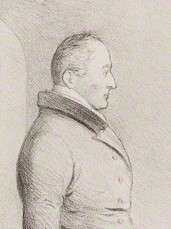Henry Parnell, 1st Baron Congleton
| The Right Honourable The Lord Congleton PC | |
|---|---|
 | |
| Paymaster-General | |
|
In office 27 April 1836 – 19 June 1841 | |
| Monarch |
William IV Victoria |
| Prime Minister | The Viscount Melbourne |
| Preceded by | New office |
| Succeeded by | Hon. Edward Stanley |
| Personal details | |
| Born | 3 July 1776 |
| Died | 8 June 1842 (aged 65) |
| Nationality | Irish |
| Political party | Whig |
| Spouse(s) |
Lady Caroline Damer (d. 1861) |
| Alma mater | Trinity College, Cambridge |
Henry Brooke Parnell, 1st Baron Congleton PC (3 July 1776 – 8 June 1842), known as Sir Henry Parnell, Bt, from 1812 to 1841, was an Irish writer and Whig politician. He was a member of the Whig administrations headed by Lord Grey and Lord Melbourne of the 1830s and also published works on financial and penal questions as well as on civil engineering. He was the great-uncle of Irish nationalist leader Charles Stewart Parnell.
Background and education
Parnell was the second son of Sir John Parnell, 2nd Baronet, Chancellor of the Irish Exchequer, and Laetitia Charlotte, daughter of Sir Arthur Brooke, 1st Baronet. His younger brother William Parnell-Hayes was the grandfather of Charles Stewart Parnell. He was educated at Eton and Trinity College, Cambridge.[1] In 1801 he inherited the family estates in Queen's County on the death of his father, bypassing his disabled elder brother according to a special Act of Parliament passed in 1789. In 1812 he succeeded as fourth Baronet, of Rathleague, on the death of his brother.[2]
Political career
Parnell represented Maryborough in the Irish House of Commons from 1798 until the Act of Union in 1801.[3] In April the following year he was elected to Parliament of the United Kingdom for Queen's County, but relinquished this seat already in July of the same year,[2][4] when he was returned for Portarlington. However, he resigned the seat already in December 1802.[2][5] In 1806 he was once again elected for Queen's County, and represented the constituency until 1832.[2][4]
It was Parnell's motion on the civil list that the Duke of Wellington's administration was defeated in 1830.[6] The Whigs came to power under Lord Grey and in 1831 Congleton was admitted to the Privy Council[7] and appointed Secretary at War,[8] a post he held until February 1833. He resigned his seat in Parliament the same year but returned in 1833 as the representative for Dundee.[2][9] When the Whigs again came to power in April 1835 under Lord Melbourne, Parnell was made Paymaster of the Forces and Treasurer of the Ordnance and Navy. These offices were consolidated into that of Paymaster-General in 1836, and Parnell retained this post until the government fell in 1841.[2] The latter year he was raised to the peerage as Baron Congleton, of Congleton in the County Palatine of Chester.[10]
Writings
Lord Congleton was also the author of several volumes and pamphlets on matters connected with financial questions, the most important being that On Financial Reform, published in 1830. He was one of the main representatives of the so-called "Free Banking School," which argued that the best way to achieve monetary stability was to revoke the Bank of England's monopoly on the issue of banknotes. These ideas were defended by Congleton and others in opposition to those of the "Currency School" (which advocated legal restrictions on the amount of notes that could be issued, with respect to their deposits in specie) and the "Banking School," which advocated discretionary policy by the banks in monetary matters. The influence of the "Free Banking School" declined significantly after Congleton's death in 1842, and the Bank Charter Act 1844 eliminated the right of new banks in England and Wales to issue notes, thus consolidating the Bank of England's monopoly, which Congleton had opposed.[11]
Lord Congleton also wrote about penal matters. In the domain of civil engineering, he authored the 1833 and 1838 editions of "A Treatise on Roads ..." in which the works and techniques of Thomas Telford are described.[6]
Family
Lord Congleton married Lady Caroline Elizabeth, daughter of John Dawson, 1st Earl of Portarlington, in 1801. In 1842, having suffered for some time from ill-health and melancholy, he committed suicide by hanging, aged 65. He was succeeded in his titles by his eldest son John. Lady Congleton died in February 1861.[2]
References
- ↑ "Parnell, Henry [Brooke] (PNL794HB)". A Cambridge Alumni Database. University of Cambridge.
- 1 2 3 4 5 6 7 thepeerage.com Henry Brooke Parnell, 1st Baron Congleton
- ↑ leighrayment.com Irish House of Commons: 1692–1800
- 1 2 leighrayment.com Queenborough to Queen's University, Belfast
- ↑ leighrayment.com House of Commons: Plymouth to Putney
- 1 2
 This article incorporates text from a publication now in the public domain: Chisholm, Hugh, ed. (1911). "article name needed". Encyclopædia Britannica (11th ed.). Cambridge University Press.
This article incorporates text from a publication now in the public domain: Chisholm, Hugh, ed. (1911). "article name needed". Encyclopædia Britannica (11th ed.). Cambridge University Press. - ↑ leighrayment.com Privy Counsellors 1679–1835
- ↑ The London Gazette: no. 18790. p. 643. 5 April 1831.
- ↑ leighrayment.com House of Commons: Dumbarton to Dysart Burghs
- ↑ The London Gazette: no. 20007. p. 2072. 13 August 1841.
- ↑ Anna J. Schwartz, "Banking School, Currency School, Free Banking School," in The New Palgrave: Money (London, W. W. Norton & Company, 1989), ISBN 0-393-02726-0.
External links
- Hansard 1803–2005: contributions in Parliament by Sir Henry Parnell
.svg.png)